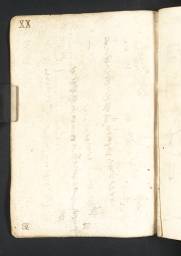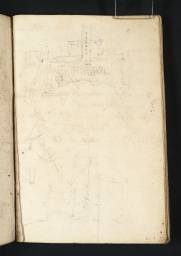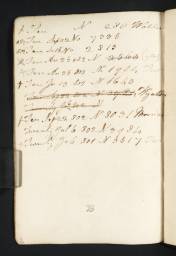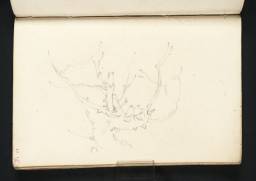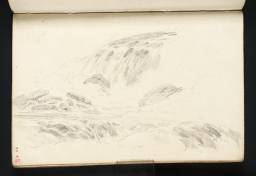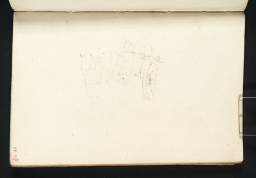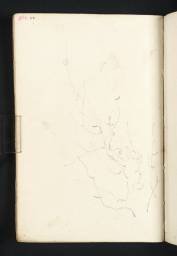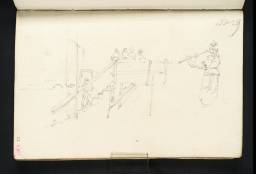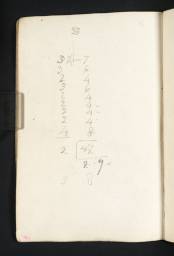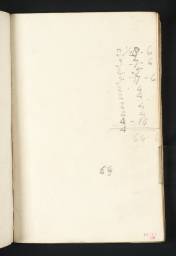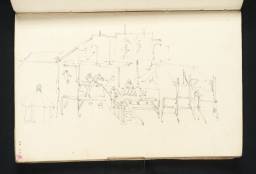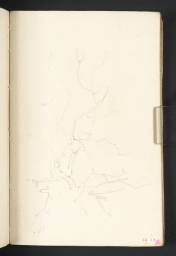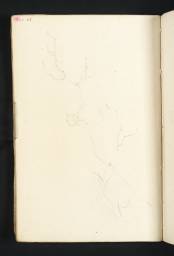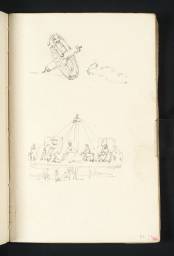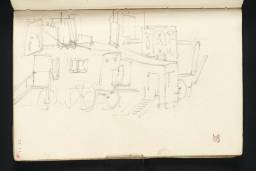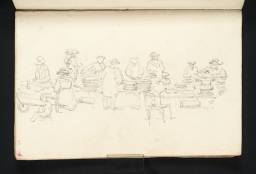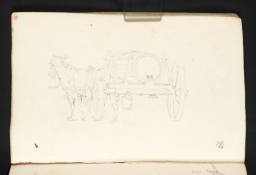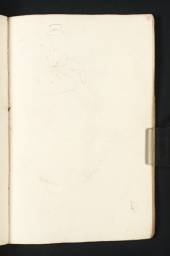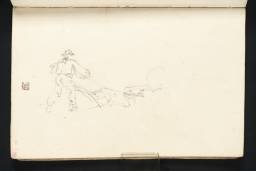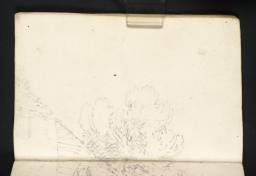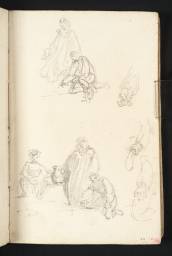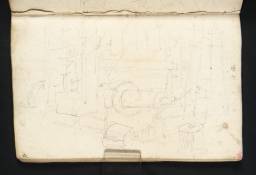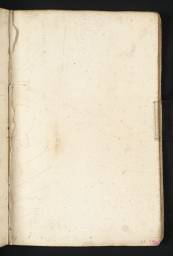Turner Bequest XX 1–44
Sketchbook bound in thin brown leather covers stuck on to blue wrapping paper pastedowns
44 leaves of white laid paper.
Watermark: Britannia in an oval; page size 152 x 99 mm.
Numbered 305 as part of the Turner Schedule, and endorsed by the Executors of the Turner Bequest, Henry Scott Trimmer, Charles Turner, John Prescott Knight and Charles Lock Eastlake in ink ‘No 305 | Contains 31 Leaves. Pencel [sic] | Sketches on both Sides – | H:S:Trimmer | C Turner’ top centre and in pencil ‘JPK’ and ‘C.L.E.’ centre left on folio 1 recto (D00260)
Stamped in black ‘XX’ inside front cover top left and inside back cover top right
Finberg records ‘Turner’s label on back 49 –’; and Ruskin’s endorsement on wrapper ‘305. Earliest Pencil. Rather interesting’
44 leaves of white laid paper.
Watermark: Britannia in an oval; page size 152 x 99 mm.
Numbered 305 as part of the Turner Schedule, and endorsed by the Executors of the Turner Bequest, Henry Scott Trimmer, Charles Turner, John Prescott Knight and Charles Lock Eastlake in ink ‘No 305 | Contains 31 Leaves. Pencel [sic] | Sketches on both Sides – | H:S:Trimmer | C Turner’ top centre and in pencil ‘JPK’ and ‘C.L.E.’ centre left on folio 1 recto (D00260)
Stamped in black ‘XX’ inside front cover top left and inside back cover top right
Finberg records ‘Turner’s label on back 49 –’; and Ruskin’s endorsement on wrapper ‘305. Earliest Pencil. Rather interesting’
Accepted by the nation as part of the Turner Bequest 1856
References
This sketchbook was named by Finberg1 on the basis of his erroneous identification of the subject drawn on folio 19 recto (D00284). A watercolour of Marford Mill, Wrexham, Denbighshire (National Museum Wales, Cardiff)2 was shown at the Royal Academy in 1795. This was based on a sketch made during the Midland tour that Turner undertook in the summer of 1794, Tate D00339 (Turner Bequest XXI L). The contents of the book seem to belong stylistically with the drawings of c.1794, which may have been started before the Midland tour. Finberg observed ‘how much like Dayes’ drawings all the sketches in this book are.’3 Edward Dayes (1763–1804) was a leading topographical watercolourist, who had employed in his studio the young Thomas Girtin (1775–1802), Turner’s friend, colleague and rival throughout the decade. Dayes’s style was a decisive influence on both artists.
Fairground scenes on folios 11 recto, 15 verso and 16 recto of this sketchbook (D00273, D00277, D00278) are possibly related to the Woolverhampton, Staffordshire subject that Turner exhibited in 1796 (Wolverhampton Art Gallery).4 The book should on this account perhaps be rechristened the Wolverhampton sketchbook. That watercolour was a direct product of the Midland tour, and the link suggests that Turner took the book with him on that journey. Wilkinson noted that this book seems to have been used in conjunction with the Matlock sketchbook (Tate; Turner Bequest XIX), and suggested that he intended to collect figure studies in it, while using the Matlock book for architecture.5 If so, this would anticipate his practice in Scotland and Switzerland by seven or eight years. However, the figure studies in the present book do not seem invariably to have been connected with the Midland tour, and some were most likely drawn in London; so the intention, if it existed, was somewhat different from that of the Scotch Figures (Tate; Turner Bequest LIX) and Swiss Figures (Tate; Turner Bequest LXXVIII) sketchbooks of 1801 and 1802 respectively.
The studies of climbing and falling men among rocks and branches on folios 36 verso, 37 verso, 41 verso and 42 recto (D00313, D00315, D00322, D00323) are apparently connected with a projected shipwreck or Deluge subject, though no work on that theme is known from these years. They may have been prompted by the exhibition in 1795 of an important picture by an Academician: John Singleton Copley’s Defeat of the Floating Batteries at Gibraltar 1782 (Guildhall Art Gallery, City of London), with its scene of a sea battle with men struggling in water and broken rigging, must have excited Turner’s interest and may well have inspired his emulation.6 His figure studies here anticipate those of climbing and falling warriors in the Dynevor Castle sketchbook (Tate D01472, D01473, D41422, D01484; Turner Bequest XL 6a, 7, 12 [verso], 13). In this connection, Dayes’s activity as a painter of historical subjects like The Fall of the Rebel Angels (Tate T05210) should be noted.
The book contains what is apparently the earliest record of Turner’s activity as a teacher of watercolour; see folio 17 recto (D00280). Some notes on drawing materials on folios 29 verso and 39 recto (D00300, D00318) may relate to this, or to the assembling of equipment for his trip to the Midlands.
The note of the numbers of cheques received in 1801 and 1802 seems to be a bit of housekeeping on a blank leaf (folio 2 verso; D00263) taken at random some years after the book had been in use by Turner. Since the handwriting seems not to be Turner’s own,7 it is most likely that of his father, who looked after some of his affairs at that time.
Technical notes
How to cite
Andrew Wilton, ‘Marford Mill sketchbook c.1794–1802’, sketchbook, April 2012, in David Blayney Brown (ed.), J.M.W. Turner: Sketchbooks, Drawings and Watercolours, Tate Research Publication, December 2012, https://www


